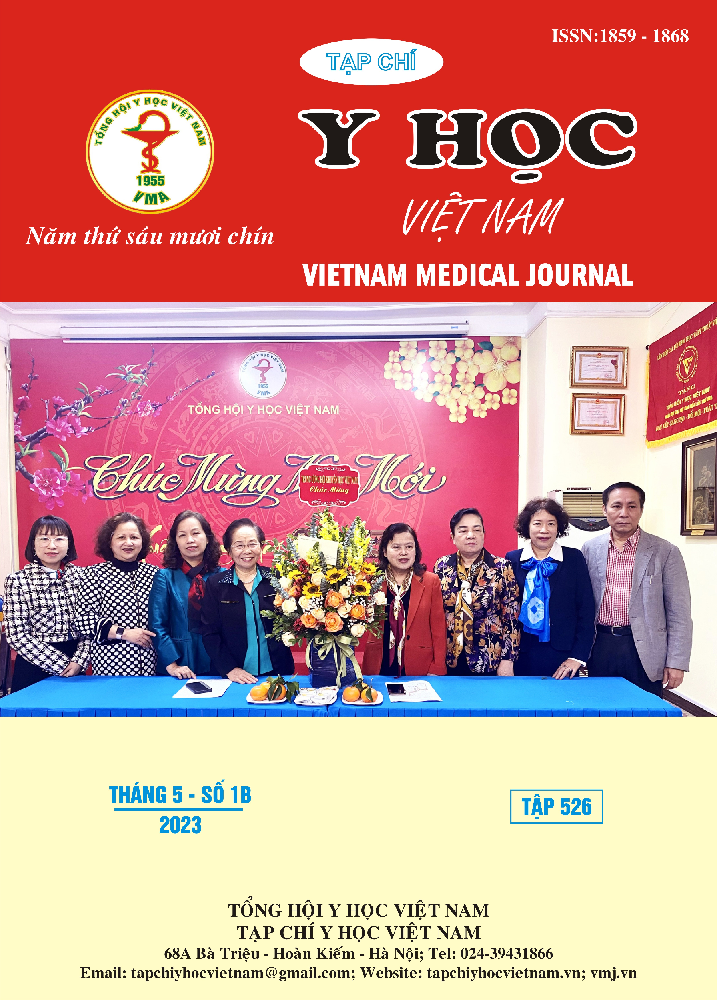THE ROLE OF SERUM BONE TURNOVER MARKERS IN MONITORING THE EFFICACY OF TREATMENT FOR OSTEOPOROSIS IN ELDERLY WOMEN
Main Article Content
Abstract
Objectives: To assess the role of serum Osteocalcin (OC) and Beta-CrossLaps (β-CTX) levels in monitoring treatment response with Alendronate in elderly women with osteoporosis. Subjects and methods: A longitudinal study enrolled 58 elderly women (≥ 60 years old) with osteoporosis treated with Alendronate at the Department of Rheumatology and Geriatrics Clinic, University Medical Center in Ho Chi Minh City from October 2021 to October 2022. The patients’ demographic information, routine blood tests, and serum levels of OC and β-CTX were recorded before and after 12 weeks of Alendronate treatment. Results: After 12 weeks of follow-up, of 58 participants, 21 elderly women with osteoporosis returned for their scheduled visit and had their serum levels of Osteocalcin and β-CTX tested before and after oral Alendronate treatment, at a dose of 70mg per week along with recommended vitamin D and calcium supplements. In elderly women with osteoporosis receiving Alendronate, the Osteocalcin level was found to decrease by 52.22% (33.08 – 52.99%) with a change of 10.4 (7.8-15.3) ng/ml before and after treatment with p<0.001. Similarly, the serum β-CTX level experienced an 80% reduction (70.00 – 81.37%) with a difference of 0.477 (0.374 – 0.500) ng/ml between pre-treatment and post-treatment measurements, with p<0.001. Based on the least significant change (LSC) threshold for serum Osteocalcin level, 80.95% of the participants demonstrated a treatment response, while 90.48% exhibited a treatment response according to both the LSC threshold and the reference interval (RI) of premenopausal women for serum β-CTX level. Conclusion: In elderly women with osteoporosis, a significant decrease in serum levels of OC and β-CTX was observed following a 12-week course of Alendronate treatment. The reduction in serum levels of OC and β-CTX indicate the short-term effectiveness of the therapy and aid in enhancing patient adherence. Furthermore, monitoring the changes in serum levels of OC and β-CTX enables clinicians to assess treatment response and take timely interventions when required.
Article Details
Keywords
osteocalcin, β-CTX, bone mineral density, osteoporosis, elderly women
References
2. Eastell R, Pigott T, Gossiel F, Naylor KE, Walsh JS, Peel NFA. DIAGNOSIS OF ENDOCRINE DISEASE: Bone turnover markers: are they clinically useful? Eur J Endocrinol. 2018;178(1):R19-R31.
3. Wu CH, Chang YF, Chen CH, et al. Consensus Statement on the Use of Bone Turnover Markers for Short-Term Monitoring of Osteoporosis Treatment in the Asia-Pacific Region. J Clin Densitom. 2021;24(1):3-13.
4. Romero Barco CM, Manrique Arija S, Rodríguez Pérez M. Biochemical Markers in Osteoporosis: Usefulness in Clinical Practice. Reumatología Clínica (English Edition). 2012; 8(3):149–152.
5. Naylor KE, Jacques RM, Paggiosi M, et al. Response of bone turnover markers to three oral bisphosphonate therapies in postmenopausal osteoporosis: the TRIO study. Osteoporos Int. 2016;27(1):21-31.
6. Trần Văn Đức, Lê Văn An, Nguyễn Hải Thủy. Nghiên cứu mỗi liên quan giữa Osteocalcin và CTX huyết thanh với mật độ xương trong dự báo mất xương và điều trị loãng xương ở đối tượng phụ nữ trên 45 tuổi. Tạp chí Y dược học. 2017;62:22-28.


